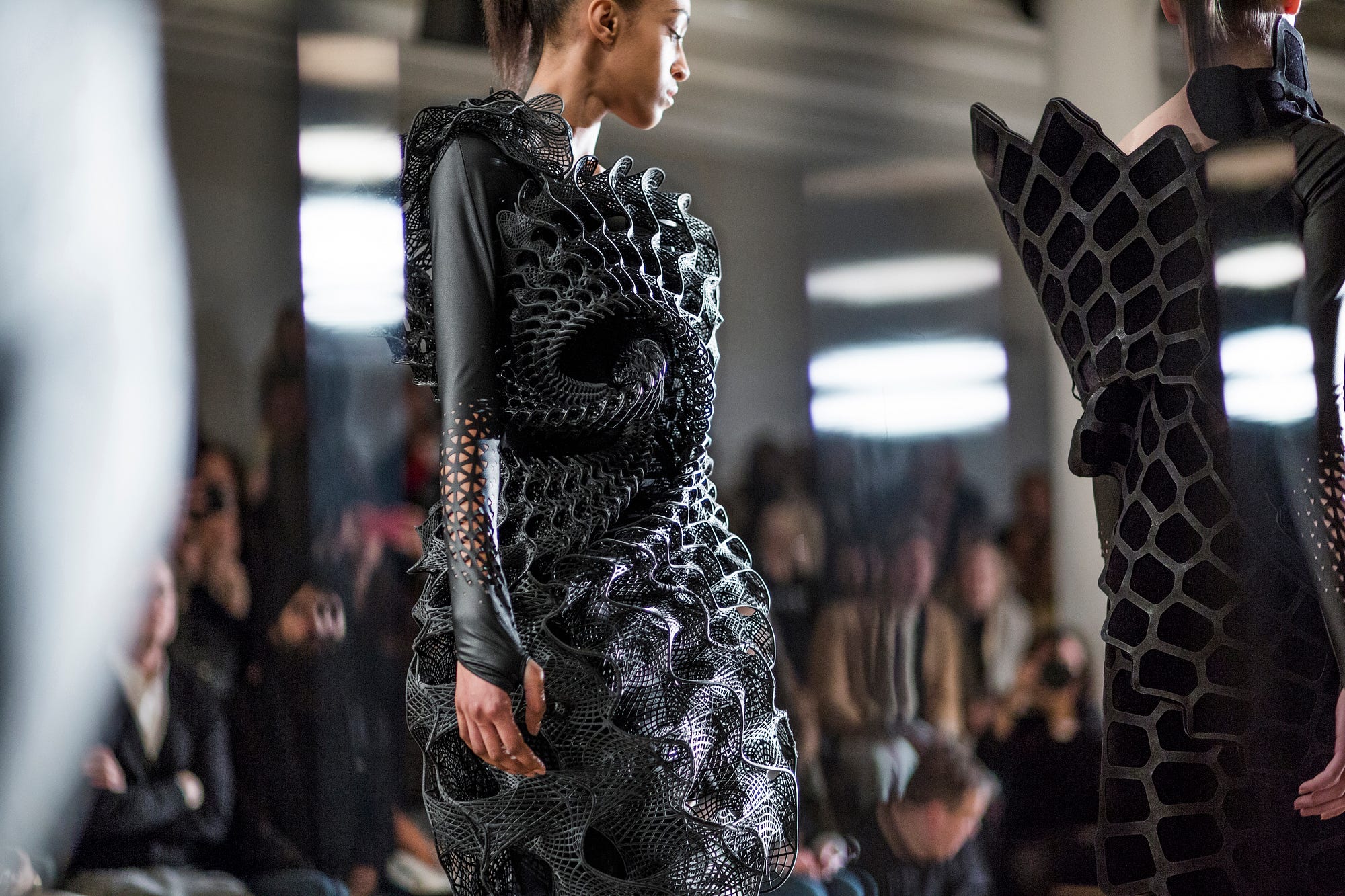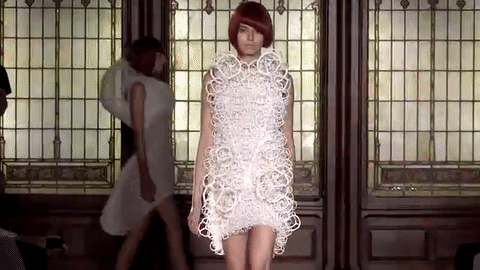
threeASFOUR’s Harmonograph Dress, part of the fall 2016 show collection, BIOMIMICRY. Designed in collaboration with Travis Fitch and 3D printed by Stratasys. (Photo: Schohaja)
When the fashion trio threeASFOUR debuted its first collection of 3D-printed clothing, a parade of auburn-haired models marched down a runway at the Jewish Museum in New York City. Their gowns looked both ethereal and geometric—the garb of angelic robots. One dress, for example, was composed of white, angular bubbles that made their wearer look like she had emerged from a very foamy bath.
But the woman who shepherded it down the runway couldn’t sit down, or the dress would shatter. “The model that was wearing it hated us,” says Bradley Rothenberg, an architect who collaborated on the project with threeASFOUR.
Follow Backchannel: Facebook | Twitter
That was in 2013, when threeASFOUR began to realize that reaching the future of fabric might require taking a few steps back. The trio at its helm — Gabi Asfour and his design partners Angela Donhauser and Adi Gil — never meant to create clothing so prone to wardrobe malfunctions. They wanted to do the opposite: stretch clothing to superhero heights. They dreamed of 3D-printing textiles that were bulletproof, fireproof, pressure-resistant, or able to trap heat or cold. In a run-of-the-mill dystopia, the garments they had in mind would fly off the shelves.
That time might be more or less now. At a moment when Silicon Valley’s elite are building personal bunkers, refugees are sneaking across the border into Canada, and Margaret Atwood is once again en vogue, threeASFOUR’s vision is not so far from where the apocalyptically minded have already gone. But where hoarding cans of Doomsday beans is within just about anyone’s reach, achieving sartorial superpowers has proven more elusive.

The reason is simple. Thousands of years of refinement have allowed traditional weaving and sewing to produce wearable, durable clothing more efficiently than an upstart method like 3D printing. But that hasn’t stopped the team behind threeASFOUR and other entrepreneurial designers from pushing the limits of fabric to see just how far — and how weird — it can go.
“With fashion there is the potential to control the weave and control the structure to get exactly the properties you want,” says Rothenberg. “The issue is that today, it’s still potential. That’s why I think Gabi [Asfour] is, like, the most exciting person in fashion. We need people like him to push the limits, to show what’s conceivable.”
Gabi Asfour has a cerebral, esoteric bent that soon becomes clear in his work. Since becoming curious about 3D printing around 2009, he has been trying to manipulate the internal geometry of textiles.
Traditional fabric is essentially two-dimensional — strands are arrayed horizontally, vertically, and in crisscross to form a weave. Asfour—who has degrees in mechanical engineering and architecture from the University of Maryland—had a vision, along with Donhauser and Gil, to create “three-dimensional interlocking weaves,” which they would achieve with the help of laser cutting. The desire to mess with fabric’s third dimension drew them naturally to 3D printing.
So far, Asfour says, “the most advanced fabric has been a four-way stretch.” That’s what’s possible with most normal fabric, which stretches along the X and Y planes. 3D printing would allow a material to stretch in the Z plane, Asfour theorized. He figured that such fabric would be more breathable and make movement easier. Best of all, it would eliminate wrinkles.
Asfour and his collaborators started asking around about 3D printing, and those inquiries eventually led to a collaboration with Materialise, a 3D-printing firm, and Rothenberg, who had designed the 3D-printed wings in Victoria’s Secret’s 2013 fashion show.
“When we started, Gabi was just like, ‘Can we make a textile out of this? Can we 3D print a fabric out of this material?’” Rothenberg says from his seat behind a table at his studio in New York’s Chinatown, where he and Gabi work. It turned out to be harder than anyone imagined.
The main challenge was that 3D-printing materials are far more rigid than the fabrics used in clothing. Over and over, they would alter the internal geometry of various materials to add more stretch to them, but once a printer deposited them in layers, those new materials would always shatter. “The practicality at the end comes and kicks your ass,” Asfour says.
As materials slowly improved, however, threeASFOUR worked up to dresses like Pangolin, a collaboration with 3D-printing company Stratasys and architect Travis Fitch, for the brand’s Fall 2016 Biomimicry collection. Pangolin took 500 hours to print, with 10 printers going at once, followed by a painstaking process of assembly. The garment, named after the world’s only scale-covered mammal, looks like something a contemporary Joan of Arc would wear: a dark yet feminine piece of armor. (Björk wore it to open her tour in Australia last year.) To achieve Pangolin’s scales, the designers used an algorithm that simulates cell division to produce its interlocking weave.
When I visit threeASFOUR’s Chinatown studio to see Pangolin in person, I pass 15 to 20 women who are working on traditional sewing machines, stitching traditional fabric swatches. The scene of their workshop looks like it could have taken place at any point in the last 50 years. Inside threeASFOUR’s studio, just one floor up, daylight streams in, hits the studio’s silver walls, and is refracted in a disco ball overhead. Up close, Pangolin’s breastplate, detached from the rest of the dress, looks and feels something like a bike tire without its tread, cut up and woven into a fish scale pattern. The piece even flops like a fish tail. It doesn’t look like a notable achievement—but just a few years earlier, that heavy droop was not possible.
Asfour hands me a piece of another dress from the Biomimicry collection: Harmonograph, which was modeled after the geometry of a sound wave. This dress was made out of a rubber mesh that can stretch and contract, like a memory foam mattress. Its latticed bustle compresses when its wearer sits and springs back into shape upon standing.
With newfound flexibility, wearers of these 3D-printed garments can now sit down, but the clothes are still far from pleasant. “It kind of looks like fake leather,” says Rothenberg—and though that’s not a bad thing in itself, it’s “very uncomfortable, and it sticks to you.”
When it first gained momentum in the early 20-teens, in the heyday of 3D printing, the idea of churning out clothing at home seemed within easy reach. But as with so many buzzy technologies, 3D-printed clothing refused to follow optimistic timelines, settling instead into a pattern of slow, stitch-by-stitch progress.
Few people know this better than Aaron Rowley, who in 2013 cofounded Electroloom, a startup for 3D-printed apparel. At first he enjoyed significant attention from big fashion brands, before watching them drop out one by one as their hopes faded. “There was this thought that people were going to want to print a spare hammer at their house,” Rowley says of the heady, hype-y days of 3D printing, which peaked around the time of Electroloom’s launch. Clothes seemed like a natural extension of that idea — a universal, everyday item that had the bonus of needing regular replenishment. But the similarities ended there. “Fundamentally the process to make a fabric is just so different from making a solid good,” Rowley says.
“Textiles are an extremely mature technology,” says Scott Hudson, a researcher at Carnegie Mellon who has collaborated with Disney to 3D print soft materials. Calling textiles a technology is not an exaggeration, because the loom is often considered an early version of a computer. In the mid-1700s, Joseph Marie Jacquard figured out how to store fabric designs on a punch card, which set the pattern for the loom to weave and automated the process.
MakerBot made a bold bet that 3D printers would become as common as microwaves. Just one problem: no one else shared…backchannel.com
3D printing has not had the benefit of the same level of refinement. With 3D printing, Hudson explains, “you run into this trade-off between stiffness and robustness.” Because 3D printers build objects by depositing layers of melted plastic one on top of the next, the layers fuse together in a manner wholly unlike the way fibers become fabric.
In Electroloom’s case, Rowley and his collaborators took the raw components of fabric and created blends closely resembling those of existing textiles. When he set out to print his designs, however, his 3D printer spat out what he says looked like a “chaotic web.” It took countless iterations before they wound up with a soft, flexible, foldable, lightweight, fibrous material that superficially resembled fabric. But even that concoction didn’t work. Give it a tug, and the material would tear. No good for clothing.
“When you have these fibers physically bonded [as in 3D printing], they aren’t going anywhere, whereas with a woven textile the fibers move and slide along each other,” Rowley explains. Electroloom shuttered last October.
Until the material problem gets solved, 3D-printed clothing will continue to look a whole lot more like an art project than an actual industry. One year ago, threeASFOUR’s dresses landed in the Costume Institute’s exhibition at the Met as part of the annual May event funded by “fashion’s biggest night out”—the Met Gala. Along with the gala, the 2016 exhibition, titled Manus x Machina, riffed on the role of technology in fashion, compelling celebrities to show up clad in a sea of silver and Zayn Malik to strut around with robot arms — efforts at futurism that were easily eclipsed by threeASFOUR’s otherworldly designs.
This year, threeASFOUR has a new 3D-printed dress: a blue-and-white ombre latticework piece that encases a mannequin in the studio. It was printed in 30 pieces that were then carefully assembled. “Like an airplane,” Asfour says.
Asfour would prefer it to be less like an airplane, and for the garment to emerge from the printer more or less ready to wear. “We are hungry for the new technology,” he says. “I feel like there is this tremendous opportunity awaiting.”
Meanwhile, other aspects of apparel, such as jewelry and athletic wear, are taking to 3D printing with much greater success. Nike and Adidas are using 3D printing to create high-performance padding and shoe soles, which typically are made out of foam with a uniform stiffness. The goal is to create a sole with “the perfect energy absorption for your foot — making it more stiff where there’s more pressure, and more flexible where there is less pressure,” Rothenberg says. NASA has a project more in line with Pangolin: a 3D-printed chain mail material meant to protect astronauts from the elements.
Or maybe not just astronauts. Though shirts and pants still rely on traditional manufacturing, protective armor might soon be ready for printing at home. Just in case there’s a revolution. Or an alien invasion. Or you need to dash for the border.
[“Source-backchannel”]
























